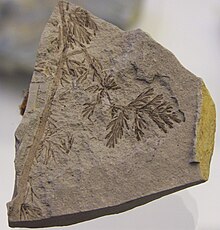Lyginopteridales
| Lyginopteridales Temporal range: Devonian–Carboniferous |
|
|---|---|
 |
|
|
Diplopteridium holdenii, Early Carboniferous Drybrook Sandstone, Forest of Dean, UK.
subdivision_ranks = families |
|
| Scientific classification | |
| Kingdom: | Plantae |
| Division: | †Pteridospermatophyta |
| Class: | †Lyginopteridopsida |
| Order: | †Lyginopteridales |
| Families | |
subdivision_ranks = families
The Lyginopteridales were the archetypal pteridosperms: They were the first plant fossils to be described as pteridosperms and, thus, the group on which the concept of pteridosperms was first developed; they are the stratigraphically oldest-known pteridosperms, occurring first in late Devonian strata; and they have the most primitive features, most notably in the structure of their ovules. They probably evolved from a group of Late Devonian progymnosperms known as the Aneurophytales, which had large, compound frond-like leaves. The Lyginopteridales became the most abundant group of pteridosperms during Mississippian times, and included both trees and smaller plants. During early and most of middle Pennsylvanian times the Medullosales took over as the more important of the larger pteridosperms but the Lyginopteridales continued to flourish as climbing (lianesent) and scrambling plants. However, later in Middle Pennsylvanian times the Lyginopteridales went into serious decline, probably being out-competed by the Callistophytales that occupied similar ecological niches but had more sophisticated reproductive strategies. A few species continued into Late Pennsylvanian times, and in China persisted into early Permian (Asselian) times, but then became extinct. Most evidence of the Lyginopteridales suggests that they grew in tropical latitudes of the time, in North America, Europe and China.
As the Lyginopteridales are the earliest-known gymnosperms, and the development of ovules was one of the key innovations that enabled seed plants eventually to dominate land vegetation, the evolution of lyginopteridalean ovules has attracted considerable interest from palaeobotanists. The most important work on these early ovules was by the British palaeobotanist Albert Long, based mainly on early Mississippian, anatomically preserved fossils from Scotland (UK).
Some of the earliest ovules (e.g., Genomosperma) consisted of a nucellus (the equivalent of the sporangium wall) surrounded by a sheath of slender axes known as a pre-integument. It is widely thought that this arrangement was derived from an ancestral condition where there was a cluster of sporangium-bearing axes, but where only one eventually retained its megasporangium, the others forming the surrounding pre-integument. Progressively, this sheath of axes became fused to form a continuous integument that surrounded and protected the nucellus, such as in Eurystoma and then Stamnostoma. These earliest ovules had the apical part of the nucellus exposed, from which there was a projection known as a lagenostome (sometimes also called a salpinx) that facilitated capture of the pollen and directed it down to the pollen chamber above the megagametophyte. In later, Pennsylvanian-age ovules such as Lagenostoma the nucellus became almost entirely encased by and fused to the integument, leaving just the small distal opening in the integument known as the micropyle through which pollen passed. Nevertheless, most lyginopteridalean ovules retained a lagenostome, despite its function in pollen capture having been replaced by the micropyle.
...
Wikipedia
